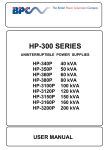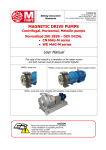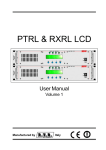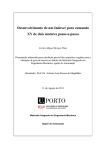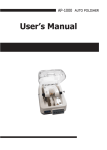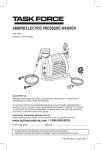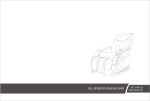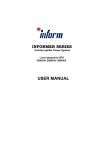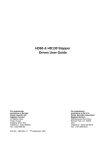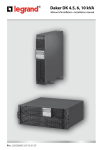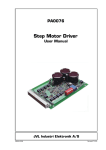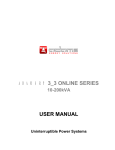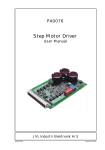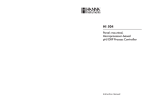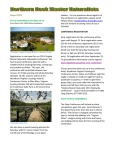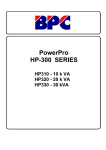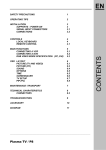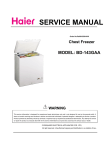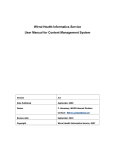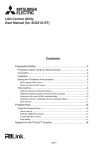Download Servostep®
Transcript
SMD103 Stepping Motor Drive User’s manual Version 2.0 Servostep® Motion Control Equipment AEC s.r.l. Via Zambon, 2/4 (z.a.) - Loc.Spessa 36051 Creazzo (Vicenza) Italy Phone +39 0444 370088 Fax. +39 0444 574958 SMD103 Stepping motor drive Reference manual Version 2.0 - January 2005 http://www.aec-smd.it e-mail:[email protected] SMD103 Version 2.0 About this manual 1.0 Overview 1.0.1 This book is a technical reference manual for the SMD103 stepper drive. It describes the operation and installation of the amplifier manufactured by AEC s.r.l. Information about cautions 1.0.2 This book may contain cautions, This is an example of caution statement. A caution statement points up a critic situation where particular care is needed. and warnings. WARNING - This is an example of warning statement When you’ll meet this message box, would be there risks for users or the drive. Related documentation 1.0.3 POTIND User’s manual - It describes the serial communication protocol. For further informations see AEC website www.aec-smd.it. Copyrights 1.0.4 All the informations and concepts included in this user guide are copyright by AEC srl and are supplied to the user with the understanding that it may not be copied, disclosed or duplicated in whole or in part for any purpose not authorised by the factory. Validity 1.0.5 Since AEC srl is constantly working to improve all of its equipments, we reserve to modify products and user guide without prior notice. -5- SMD103 Version 2.0 IMPORTANT NOTES 2.0 Please read these notes carefully before powering up the drive It is very important meet all applicable safety requirements during installation and operating of any AEC’s motion control equipment. Any installer has to assume the responsibility to ensure that he recognizes and complies all the relevant safety standards. Any installation, not meeting the safety requirements, may damage the equipment or injury the user. AEC’s motion control equipment shoul be handled, installed, setted-up and maintenanced only by competent personnel expert and trained in the installation of motion control electronic equipment. Such technicians should be aware of potential electrical and mechanical hazards . AEC s.r.l. shall never be liable or have any responsability if the products have been improperly stored, installed, used or maintened, or if the costumer has permitted any unauthorized modifications, adjustments, and/or repairs to the products. CAUTION 2.0.1 Users must keep well clear in mind that AEC’s motion control equipment is capable of producing high forces and rapid movement so they must be used with attention especially during the application program’s development. AEC’s motion control equipments are sold as end-users products to be installed only by practical staff in accordance with all local safety laws and regulations. The device have to be enclosed such that any part is not be accessible while the system is powered on. AEC srl strongly reccomend to follow these recommendations in order to avoid wrong uses of the equipment that may be impaired all the protections provided by the device. -6- SMD103 Version 2.0 CONTACTS 3.0 For technical assistance: AEC s.r.l. Motion Control Division Via Zambon, 2/4 (z.a.) - Loc. Spessa 36051 CREAZZO (Vicenza) Italy Phone +39 0444 370088 Fax. +39 0444 574958 E-mail:[email protected] For engineering assistance: AEC s.r.l. Motion Control Division Via Zambon, 2/4 (z.a.) - Loc. Spessa 36051 CREAZZO (Vicenza) Italy Phone +39 0444 370088 Fax. +39 0444 574958 E-mail:r&[email protected] Sales office: AEC s.r.l. Motion Control Division Via Zambon, 2/4 (z.a.) - Loc. Spessa 36051 CREAZZO (Vicenza) Italy Phone +39 0444 370088 Fax. +39 0444 574958 E-mail:[email protected] -7- SMD103 Version 2.0 CONTENTS About this manual Overview Informations about cautions Related documentations Copyright Validity Important notes Caution Contacts Contents Overview of the Servostep® serie Product features SMD103: technical specifications Agency approvals Power input Power output Control Digital inputs Digital outputs Protections Status LED indicators Mechanical and environment SMD103 : features Typical installation Warrants conditions Attention Installation Responsability Shielding and grounding Ambient conditions Drive cooling Mechanical installation Mounting guidelines Electrical installation Caution Keep in mind ... Power supply connections Wiring notes Transformer selecting Motor connections Caution Motor connection types -8- 1.0 1.0.1 1.0.2 1.0.3 1.0.4 1.0.5 2.0 2.0.1 3.0 4.0 4.1 4.2 4.2.0 4.2.1 4.2.2 4.2.3 4.2.4 4.2.5 4.2.6 4.2.7 4.2.8 4.3 4.4 4.5 4.5.1 5.0 5.0.1 5.0.2 5.0.3 5.0.4 5.1 5.1.1 5.2 5.2.1 5.2.2 5.2.3 5.2.4 5.2.5 5.2.6 5.2.7 5.2.8 5 5 5 5 5 5 6 6 7 8 10 11 12 12 12 12 13 13 14 15 15 15 16 17 18 18 19 19 19 20 20 21 21 22 22 22 23 24 24 25 25 26 SMD103 Version 2.0 Current setting notes Motor wiring identification tables Digital signal interface Control signals Connection diagram Setting up the drive Current motor setting Step resolution Equalization Automatic current reduction Step-IN edge Drive LEDS indications Testing the installation Caution Mechanical test Wiring test Voltage level test Setting up checking Signal test Need help? Appendix A Axis outlines Speed vs Time profile Boost Hardware summary Drive specifications - SMD103 Environment specifications - SMD103 5.2.9 5.2.10 5.2.11 5.2.12 5.2.13 5.3 5.3.1 5.3.2 5.3.3 5.3.4 5.3.5 5.4 5.5 5.5.1 5.5.2 5.5.3 5.5.4 5.5.5 5.5.6 5.5.7 6.0 6.0.1 6.0.2 6.0.3 7.0 7.0.1 7.0.2 -9- 27 28 30 31 32 33 34 34 34 35 35 36 38 38 38 38 38 38 39 39 40 40 41 42 43 43 43 SMD103 Version 2.0 Product features 4.1 The SMD103 stepper drive is one of the smallest and powerful, drives now available. The drive is capable to obtain the maximum power from the motor and have optimal performances where the conditions are particularly difficult. For being able to use in every type of installation, the drive implements some protection circuit, status indicators and input/output. Protection circuits Motor short circuits, phase to phase, phase to ground, phase to H.V. Over-voltage Under-voltage Drive over-temperature Status indicators (LED) High Voltage status Current Off status Current Full status Fault status Inputs and outputs Step input Direction input Current Off input Current Reduction input Fault output -10- SMD103 Version 2.0 SMD103: technical specifications 4.2 Agency approvals 4.2.0 • CE Compliance: 89/336/EEC Electromagnetic EN 55011 Compatibility EN 550082-1 98/37/EC Safety of Machinery EN 60204-1 CONDITIONS OF ACCEPTABILITY 1. The devices shall be installed in compliance with the enclosure, moun ting, spacing, and segregation requirements of the ultimate application. 2. These devices are intended as open type equipment. The need to repeat a temperature test shal be considered in final end use application 3. Motor overload protection is not provided and should be considered in the end product. 4 These devices are suitable for field wiring. Power Input Main Voltage Supply current 4.2.1 Min. Typ. Max. Units Nominal values, including ripple up to ±10% 12 24 36 Vdc Absolute maximum values continuous ! 10 40 Vdc Nominal value 0.12 Peak The power supply voltage has to be a DC isolated voltage -11- 1.6 A 3 A SMD103 Version 2.0 Power Output 4.2.2 Min. Output current Typ. Max. Units RMS current 0.5 3 A Absolute maximum values continuous ! 0.5 3 A Control 4.2.3 Output stage Dual MOSFET H-bridges Control mode Bipolar chopper Chopper frequency 20 KHz Voltage Compensation Changes in voltage do not affect current control Digital inputs 4.2.4 The SMD103 drive is provided of four control digital inputs. Type Optoinsulated with constant current absortion Logic 5 - 24Vdc PNP or NPN no resistors needed Scan time Real time Debounce fixed Electrical characteristics (All voltages are referred to Digital Commom) Input Voltage Input current Input Frequency Min. Typ. Max. -5 0 1.2 2.4 24 30 LOW Logic state 0 0,2 HIGH Logic state 3 8 LOW Logic state HIGH Logic state Absolute maximum, surge (≤ 500ms) ! -10 Units V 50 mA General purpose inputs 0 5 KHz High speed inputs 0 80 KHz -12- SMD103 Version 2.0 Digital outputs 4.2.5 The SMD103 drive is provided of one NPN Fault digital outputs. Type Sinking, optoinsulated open-collector Logic 5 - 24Vdc PNP Scan time 1 ms Function Fault Electrical characteristics (All voltages are referred to Digital Commom) Ouput Voltage HIGH Logic state (+24 Vdc Aux Voltage - 2W external load) Absolute maximum(Iout=350mA, L=2.0mH), surge (≤ 500ms)! Min. Typ. Max. -5 0 1.2 -0.5 5.0 LOW Logic state (Leakage current) Output current 35 200 Units V µA 350 HIGH Logic state 370 Shutdown Threshold 500 mA ! Stresses beyond those listed under “absolute maximum ratings” may cause permanent damage to the device. Extended periods exposure to absolute maximum rating may affect device reliability. -13- SMD103 Version 2.0 Protections 4.2.12 Min. Current short circuit or overload Temperature Maximum surrounding air 50 ˚C Typ. Max. 3 A ˚C Status LED indicators Led H.V. C.OFF C.FULL FAULT 4.2.7 Color Green Green Green Meaning ON Normal operation (supply voltage within the range) OFF Undervoltage or fuse blowned-up ON Power output disable OFF Power output enable (motor energized) ON Nominal setted current supplied OFF Half setted current supplied ON - Wrong motor phase connection - Short circuit between phase and ground or H.Volt. Red - Undervoltage when HV light on OFF Normal operation Mechanical and environment 4.2.8 Min. Dimensions Typ. Max. 80 x 100 x 30 Width x Lenght x Height Weight Ambient Temperature Units 200 Operating Storage (not powered) Units mm g 0 50 -40 85 ˚C 0 95 %RH Humidity Non-condensing Contaminants Pollution degree Cover material Flammability rating Cooling Convection or forced cooling required for continuous power output ˚C 2 or better -14- Aluminum - meet 94 V-0 SMD103 Version 2.0 SMD103 : features 4.3 Bipolar chopper drive PWM (pulse width modulation) chopping electronically controls the motor windings current at 20 KHz obtaining a powerful energizing of the motor phase. The SMD103 optimizes the re-circulating current to obtain the best possible performances in stepper motor driving. Protection circuits Many protection circuits have been implements to guarantee a good drive protection in every situation. The drive is protect against short circuit on the motor outputs, over voltage, over temperature. Every time that the drive goes in protection it disables the current output to the motor phases. Optocoupled inputs All the control inputs/output are optocoupled and permit a wide range of solutions during installation. All the inputs can be used in NPN or PNP logic and can accept input voltages between 5 and 36 Vdc without any external components. Motor current The output motor current can be setting using “SWA” dipswitches from 1.8 to 6 A rms selectable through eight levels. Automatic current reduction This control automatically reduce the output motor current to the 50% of the nominal value 100 ms after the last input step pulse occurs. The current will return at its nominal value at the next step pulse. Step edge Allows to selection if the step occurs during the rising edge or during the falling edge of the step signal. -15- SMD103 Version 2.0 Typical installation 1.4 4.4 Power supply 24 Vdc 1 2 D. I N P U T I N T E R F A C E STEP + DIR + CONTROL UNIT C.OFF + C.RED + FAULT SIGNAL GROUND 3 4 5 6 A -A B -B -16- SMD103 Version 2.0 Warrants conditions 4.5 All AEC’s equipment have two years warranty against defect in materials and assembly . Wrong installation, miswiring, incorrect settings up, fuse blown up, phisical mishandling, modifying by the customer avoid warranties. Attention 4.5.1 Don’t try to remove the label, any tampering will result in warranty voiding. WARNING - Risk of damage and/or personal injury AEC’s drives doesn’t contain any user serviceable part. Attempting to open the case, or to replace any internal component, may result in damage to the unit and/or personal injury. This may also void the warranty. WARNING - Risk of damage and/or personal injury Motor overload protection is not provided and should be considered in the end product. -17- SMD103 Version 2.0 Installation 5.0 Responsability 5.0.1 As the end user or installer applying this equipment, it is your responsability to determine the suitability of the product for any your’s application. AEC s.r.l. will never be responsable or liable for any damage resulting from a wrong installation or a wrong use of this products. Be sure that all wiring complies the local or standard wiring codes. Danger: Hazardous voltages. Exercise caution when installing and setting up. Failure to heed this warning may cause damage, injury, or death. With the exception of M1 and M2 plug connectors, all of other circuits are mains connected and must never be grounded. Failure to heed this warning may cause device damage. Shielding and grounding Motor Interface Power M 1 Stage Power Input/output SMD103 DC Supply 5.0.2 M 3 Step IN, Direction, Current control, Fault M 2 The control circuit share a common circuit-ground, so it’s enough to connect only a point to ground all the internal circuits (analog, serial). All the ground paths shall be the shortest paths possible in order to minimize noise. Never ground secondary transformer in order to avoid internal diode short circuit. -18- SMD103 Version 2.0 Case and shield terminal, internal wired, has to be connected to the system chassis ground, keeping the wire as short as possible. This improve the shielding effect of the case, and provide a good path to ground noise currents that may occur in the cable shields Shielding It is hard reccomended that connections to the motor, power, I/O and serial signals be made using shield cables. They help to reduce the emmissions from the drive and help to protect the internal circuits from interferences due to external sources of electrical noise. A good system shielding is also required for CE compliance. Cable shields should be tied to earth or system ground. Ambient conditions 5.0.3 AEC’s power drives are intended only for use in close locations, guarded from operator contact, in an ambient that compliance with these characteristics: operating temperature of maximum 50 °C, Humidity limits between 5% to 95% non condensing (Pollution degree 2 or better). The drives have to be supplied from an isolating transformer or a DC isolated power supply. For environment temperature above 50°C (122°F), forced -air cooling is required. (See hardware reference) Drive cooling 5.0.4 The drive is natural convection air flow cooled. To ensure the drive cooling and make the installation easier for the operator it must be installed vertically leaving a free space of at least 5 cm (2 in) on each side of the device. Avoid mounting heat producing equipment in the nearest of the drive or any other device that can obstruct natural or forced convention air flow. -19- SMD103 Version 2.0 Mechanical installation 5.1 Mount the drive vertically 2 3 4 5 6 7 8 9 10 11 12 90 81.8 30 1 Spring fixing hole for omega guide 67 80 100 Dimensions are expressed in millimeters. The SMD103-I drives can be installed either in profile or flat using the relative grooves on the heat-sink and the supplied brackets. Mounting guidelines 5.1.1 • Vertical orientation for the device. • Minimum unobstructed space of 5 cm (2 in) all around the unit. • Flat surface capable of supporting the approximate 630 g mass of the drive (or 1.4 lb weight) • Free of excessive vibrations • Maximum heat-sink temperature 70°C (158°F) -20- SMD103 Version 2.0 Electrical installation 5.2 The drive must be installed in an enclosure to protect the electronic parts from atmospheric contaminants. In no case, the acces to the device must be possible while it is powered up. Metal cabinets are ideally suited for housing the AEC’s equipments, since they can provide operator protection, EMC screening, and can be fitted with interlocks to remove all hazardous powers when the cabinet is open. In no case interlocks must open motor phase connections while system is still powered, as this could cause damages to the contacts and the drive. During the installation, use normal precautions against damages caused by electrostatic discharges (wear earth wrist straps). Remember to include a circuit breaker, wich must be clearly marked as the disconnecting device and should be within easy reach of the operator. Caution 5.2.1 All the circuits in the SMD103-I are potential sources of severe electrical shock, so follow these rules to avoiding possible personal injury. 1. Power off the drive and wait until all the leds are turned off before touching, removing, connecting or any other critical action. 2. Tied the motor case to earth ground before powering up the drive. 3. Never disconnect any connectors before powering down the drive. Keep in mind ... 5.2.2 In case of doubt or in any case you don’t know as to behave yourself, before access to the drive, power off the device and wait until all the leds are turned off. May you have attention when you touch the drive because it may be hot. -21- SMD103 Version 2.0 Power supply connections 5.2.3 The SMD103 need only a DC power supply for the drive . It can be supply in DC voltages between 10V and 36V. Normally, the powering voltage is obtained directly from the a rectified secondary winding of an isolating transformer. Note: If the drive is DC voltage powered, the power supply must be isolated from the mains. Description Female, single row 12 ways Manufactorer PN Phoenix Contact GmbH MSTB 2,5/12-ST Wire size 14 - 18 AWG Tightening torque torque 2 - 4 lb / 9 - 18 N Use only 60/75˚C copper wire only. Pinout 1 2 3 4 5 6 7 8 9 10 11 12 Terminal block Name Description DC power supply 1 DC + Positive pole 2 DC - Negative pole Avoid stress on the connector by hanging cables, as this may lead to connector over-heating. Keep clear in mind that input power supply must been as stable as possible and is extremaly important that it never exceeds 45 DC volts. Everytime the supply voltage rises above the limit even for a time it can causes drive’s damage. -22- SMD103 Version 2.0 Wiring notes 5.2.4 The plug connector terminals will accept 16 to 30 AWG wire, but AEC recommends to use 16AWG or heavier for power supply and motor wiring. In multi-axis configurations don’t daisy-chain power connections but reach any device with a single power supply line. It is advisable to connect an EMC filter placed on the secondary side of transformer to suppress noises from the mains. Note: Never insert or disconnect mating connector terminals when the device is powered up. Anyway make sure the terminals screws are tightened down firmly on the wiring to avoid contacts damages. Transformer selecting 5.2.5 Transformer’s size required depends on the application and on the maximum shaft power delivered by the motors. To optimize the power supply design, the supply current can be measured by a current meter when the motor is producing the highest shaft power. If is it too hard to make this measurement, assume load current equals the nominal current selected by dip-switches. However the RMS current demanded to the transformer is even lower because the drive works in chopper mode supplying pulses of current at 20 KHz to the motor. The maximum absorbable power from the SMD103-I is approximatively 80 VA.In multi-axis configurations the peak current requests depend on the maximum number of the axis running simultaneously; drives who are stop or stationary used little power if are in the current reduction or current off state. Often,especially in limited series, is not convenient spend a lot of time and resources to calculate the minimum possible rating but is preferable to be slightly generous in sizing transformer. In high volume series measure the supply current will give a useful guide to the transformer dimensioning. -23- SMD103 Version 2.0 Motor connections 5.2.6 AEC recommend a 16 AWG wire size to connect motor to the drive. Use cables with two twisted (or screened) pairs for motor phase excitation and a fifth wire for motor case grounding. To reduce radiation noise is possible shield the motor cable connecting the braided screens to the ground. Description Female, single row 12 ways Manufactorer PN Phoenix Contact GmbH MSTB 2,5/12-ST Wire size 14 - 18 AWG Tightening torque 2 - 4 lb / 9 - 18 N Use only 60/75˚C copper wire only. Pinout 1 2 3 4 5 6 7 8 9 10 11 12 Terminal block Name Description 3 Phase A Motor phase A 4 Phase -A Motor phase -A 5 Phase B Motor phase B 6 Phase -B Motor phase -B Avoid stress on the connector by hanging cables, as this may lead to connector over-heating Caution 5.2.7 Power supply and motor cables are sources of heavy radiated noise. It is advisable to keep them separate from any other low-level control signal cables to avoid any interference with control signals. If power cables are not shielded, the control signal cables must be kept almost 300 mm (12 in.) away from power cables. -24- SMD103 Version 2.0 Motor connection types 5.2.8 With the AEC’s stepper motor drives can be used indipendently 4, 6 or 8 wires (serial o parallel configuration) stepper motors. 4 wires motor connection 1 2 3 4 5 6 A+ AB+ B- 7 8 9 10 11 12 8 wires motor parallel connection 1 2 3 4 5 6 A+ AB+ B- 7 8 9 10 11 12 8 wires motor serial connection 1 2 3 4 5 6 A+ AB+ B- 7 8 9 10 11 12 -25- SMD103 Version 2.0 6 wires motor serial connection 1 2 3 4 5 6 A+ AB+ B- 7 8 9 10 11 12 Current setting notes 5.2.9 Every connection type have a different current setting. Motor Type Connection Type 8 wires parallel connection Iph x √2 8 wires serial connection Iph / √2 4 wires / 6 wires 1 winding per phase Iph Iph = Phase current declared by manufacturer -26- Phase current SMD103 Version 2.0 Motor wiring identification tables 5.2.10 The following tables riassumes serial and parallel connection information of most common stepper motor used. Manufac. Type A+ A- B+ B- Tamagawa 8 wires Blk/Wh&Or Blk&Wh/Or Yel&Wh/Red Wh/Yel&Red Tamagawa 6 wires Black Green Red Blue Tamagawa 4 wires Blue Red Yellow White Oriental Mot 8 wires Blk&Or Grn&Yel Red&Brw Wh&Bl Oriental Mot 6 wires Black Green Red Blue M.A.E. 8 wires Blk/Wh&Or Blk&Wh/Or Yel&Wh/Red Wh/Yel&Red M.A.E. 6 wires Black Orange Yellow Red M.A.E. 4 wires Grn Wh/Grn Red Wh/Red Sanyo Denki 8 wires Blk/Wh&Or Blk&Wh/Or Yel&Wh/Red Wh/Yel&Red Sanyo Denki 6 wires Orange Blue Red Yellow Sanyo Denki 4 wires Orange Blue Red Yellow Pacific Scientific 8 wires Blk/Wh&Or Blk&Wh/Or Yel&Wh/Red Wh/Yel&Red SLO-SYN 6 wires Wh/Grn Green Wh/Red Red SLO-SYN 4 wires Blk Wh/Blk Wh/Red Red Sonceboz 8 wires Grn&Blk/Wh Or&Grn/Wh Red&Wh Blk&Wh/Red Japan servo 6 wires Black Brown Yellow Orange Japan servo 4 wires Red Blue Yellow White ESCAP 6 wires Black Green Red Blue ESCAP 4 wires Black Green Red Blue Zebotronics 8 wires Brn&Wh Blk&Red Blue&Gry Yel&Grn Bodine 8 wires Brn&Wh/Or Wh/Brn&Or Wh/Red&Yel Red&Wh/Yel DPM 4 wires Red Blue Green Black DPM 4 wires Red White Green Yellow Key Notes Wh&Yel N.C. Wh&Yel N.C. Wh&Blk N.C. Wh&Blk N.C. Wh & Blk N.C. Red&Bl N.C. Wh&Yel N.C. Motor connections - Windings in parallel Blk = Black Gry = Grey Brn = Brown Or = Orange Wh = White Yel = Yellow -27- SMD103 Manufac. Version 2.0 Type A+ A- B+ B- Notes Yellow LinkWh/Blk&Wh/Or, linkWh/Red&Wh/Yel Wh&Yel N.C. Tamagawa 8 wires Black Orange Tamagawa 6 wires Black Green Red Blue Tamagawa 4 wires Blue Red Yellow White Oriental Mot 8 wires Black Green Red Blue Oriental Mot 6 wires Black Green Red Blue Wh&Yel N.C. Yellow LinkWh/Blk&Wh/Or, linkWh/Red&Wh/Yel M.A.E. 8 wires Black Red Orange Red Link Yel&Or, link Wh&Brn M.A.E. 6 wires Black Orange Yellow Red M.A.E. 4 wires Green Wh/Grn Red Wh/Red Wh&Blk N.C. Sanyo Denki 8 wires Black Orange Red Yellow LinkWh/Blk&Wh/Or, linkWh/Red&Wh/Yel Sanyo Denki 6 wires Orange Blue Red Yellow Wh&Blk N.C. Sanyo Denki 4 wires Orange Blue Red Yellow Pacific Scientific 8 wires Black Orange Red Yellow LinkWh/Blk&Wh/Or, linkWh/Red&Wh/Yel SLO-SYN 6 wires Wh/Grn Green Wh/Red Red Wh & Blk N.C. SLO-SYN 4 wires Blk Wh/Blk Wh/Red Red Sonceboz 8 wires Grn&Blk/Wh Or&Grn/Wh Red&Wh Blk&Wh/Red Japan servo 6 wires Black Brown Yellow Orange Japan servo 4 wires Red Blue Yellow White ESCAP 6 wires Black Green Red Blue ESCAP 4 wires Black Green Red Blue Zebotronics 8 wires Brn&Wh Blk&Red Blue&Gry Yel&Grn Bodine 8 wires Black Orange Red Yellow Motor connections - Windings in series Key Blk = Black Gry = Grey Brn = Brown Or = Orange Wh = White Yel = Yellow -28- Red&Bl N.C. Wh&Yel N.C. LinkWh/Blk&Wh/Or, linkWh/Red&Wh/Yel SMD103 Version 2.0 Digital signal interface 5.2.11 The digital signal interface accepts control signals from many different sources like indexeres, PLC, Digital signal generator or other any sources. The control signals can be either NPN or PNP logic. All digital inputs/outputs refer to terminal 2 (Digital common). Description Female, single row 12 ways Manufactorer PN Phoenix Contact GmbH MSTB 2,5/12-ST Wire size 14 - 18 AWG Tightening torque 2 - 4 lb / 9 - 18 N Use only 60/75˚C copper wire only. Pinout 1 2 3 4 5 6 7 8 9 10 11 12 Terminal block Name Description 7 N/C No Connection 8 Fault Drive fault output 9 CUR.OFF Current null 10 CUR.RED Current reduction 11 DIR 12 STEP-IN -29- Direction Steps input SMD103 Version 2.0 Control signals 5.2.12 STEP INPUT Terminal 12 Input used to command motor rotation. A step is taken forward during signal transition from high to low logic level or low to high logic level (dip-switch 8). Minimum impulse duration 15 microseconds. It is advisable, whenever possible, to use a 50% duty cycle. DIRECTION Terminal 11 Input used to change the direction of motor rotation. If the motor is correctly connected, the motor will turn clockwise if DIR is disable, counterclockwise if enable. The logic level must be valid for at least 50 microseconds before the step signal and staying unchanged for at least 50 microseconds after the last step impulse. CURRENT OFF Terminal Input used to enable or disable the power current output of the drive. 9 When this input is at a low logic level, current is present at the motor’s phases. If the logic level is high, the current at the phases is annulled. EXTERNAL CURRENT REDUCTION Terminal 10 Input used to reduce current output to the motor When this input is at a high logic level the drive supplies the current set with the dip-switches. If at a low logic level, the erogated current is reduced by 50% (see application notes). DRIVE FAULT Terminal 8 Output used to carry out the drive status. Normally low, this signal moves to high logic level when a protection occurs. The relative alarm LED lights up to show the event. -30- SMD103 Version 2.0 Control signals 5.2.13 Gnd SIGNAL SOURCE 2 Common 9 C.Off 10 C.Red 11 Dir 12 Step Connection diagram in NPN configuration Gnd SIGNAL SOURCE 2 Common 9 C.Off 10 C.Red 11 Dir 12 Step 24 Vdc Connection diagram in PNP configuration -31- SMD103 Version 2.0 Setting up the drive 5.3 Before powering up the drive you must setting up the current level, the step resolution and all the parameters. All the drive settings can be changed by the dip-switches SW A. SW A settings 1 2 3 OFF OFF OFF OFF Current (A) SW A set. 5 6 OFF 3 OFF OFF ON 2.6 ON OFF 2.3 OFF ON ON 2 ON OFF OFF 1.6 ON OFF ON 1.2 ON ON OFF 0.9 ON ON ON 0.5 -32- step resolution OFF FULL(2phaseON) OFF ON WAVE(1phaseON) ON OFF HALF ON ON QUARTER SW A set. 4 Equalization OFF Enable ON Disable SMD103 Version 2.0 Current motor setting 5.3.1 The 1st,2nd and 3rd positions of Dip-switch A allow to change curret level choosing it between eight. Current should be compatible with motor current requirements. Note: Higher the current, higher power dissipation of the drive, so increase cooling at high current levels to keep heatsink below 70°C (158°F). Step resolution 5.3.2 Step resolution defines the minimal angle of rotation per step. It can be setted choosing it between four sizes available. The common used step size is half step that, in 1,8° stepper motor, corresponds to 400 steps per revolution. Step per revolution can be obtained using the following table only for 1,8° steppe motor (200 physical step per revolution). Step resolution full (2 phase ON) 200 wave (1 phase ON) 200 half 400 quarter 800 Equalization 5.3.3 Resonance phenomenas typical of all stepping motor at medium frequencies increase when physical step is divided by the drive. To avoid this phenomenon AEC’s drives have implemented an equalization functionality that increase motor current when is working a phase alone. Dip-switch A(position 4), generally set at OFF. In case of resonance at medium frequencies, approx. 1000 step/” at half step and approx. 2000 step/” at quarter step, set at ON. -33- SMD103 Version 2.0 Automatic current reduction JP1 5.3.4 JP2 Automatic current reduction reduces output current every time the motor is not moving. The switch to the reduced current level occurs 100 ms after the last step impulse received. If JP2 is set for automatic current reduction (OPEN), each time the motor stops the current decreases by 50% of the nominal current. Automatic current reduction must only be excluded in full cognition of facts. Input polarity selection 5.3.5 With JP2 jumper it is possible to define the polarity (NPN or PNP) of the stepper drive. -34- SMD103 Version 2.0 Drive LEDS indications 5.4 Any function of the drive can be monitored by the drive status LED. The SMD103 have 4 indications leds, that display current status, voltage status, faults or over temperature. Everytime your system has malfunctions check the led’s status on the top of the drive. If no leds are turned on, verify that power supply is turned on and that the M1 terminal block is correctly inserted. When drive is correctly supply, all connectors are inserted but the leds are still turned off, disconnect the drive wait for a while to descharge any accumulator device and control the power supply. H.V. LED In normal operation this led is light up, if it is off indicates something wrong in power supply or the fuse is blowned up. C.OFF LED Everytime the drive output current is enabled this LED is light up. When the LED’s turned off motor phases are not energized. -35- SMD103 Version 2.0 C.FULL LED This LED light up when the output current is at its nominal value and not reduced. FAULT LED This LED indicates any type of drive’s malfunctioning; there are many reason that can create a system fault, first of all wrong connections. Fault condition maybe due to any of the following causes: • wrong connection. Motor phases have been connected in wrong way or the motor cables have been wrong coupled. • short circuit between phases and ground or phases and Power sup ply • under voltage. Input supply voltage level too low to powering up the system, when the HV LED is turned off. -36- SMD103 Version 2.0 Testing the installation 5.5 After the system installation, before powering up the drive, please check carefully all connections, voltage levels and all the requirements you have to met. Caution 5.5.1 It is highly reccomended to perform the first power up with motor shaft disconnected from any load to avoid any undesired motion and prevent things damages and personal injuries. Be ready to power off the drive if undesired motion control occurs. Mechanical test 5.5.2 Check that drive is firmly fixed with a free space all around of 5 cm (1.97in), that there aren’t other heat sorces closed to the drive and without barriers who stop natural or forced air convection. Take a look carefully that there aren’t burrs in the nearest of the drives. Wiring test 5.5.3 Check that all the wires are tightly connected in the right place and that the wiring meet all safety guidelines and is in accordance with all local safety laws and regulations. Voltage level test 5.5.4 Before inserting M1 connector control that voltage level is into the right values and not exceed maximum absolute ratings. It is very important to do this because if supply voltage exceed 45 Vdc it causes drive breackdown. Setting up checking 5.5.5 Control that all the dip switches are correctly setted and the setup current never exceed motor ratings. Need help? 5.5.6 If you need further assistance wuth your installation, please contact us or your local distributors. -37- SMD103 Version 2.0 Signal test 5.5.6 After successfuly perform all the aforesaid tests, power on the drive and verify that HV LED light up and motor has holding torque by attempting to rotate the shaft. Give input step signal and control if motor rotation is in right direction. If not , power off the system and exchange the phase A with the phase A-. Changing the direction signal polarity, the motor shaft should invert its rotation. Need help? 5.5.7 If you need further assistance wuth your installation, please contact us or your local distributors. -38- SMD103 Version 2.0 Appendix A 6.0 Axis outlines 6.0.1 STEP DIR SMD103 C.RED C.OFF Axis ctr FAULT Target FLS BLS Carriage Stepper AXIS Direction movement -39- SMD103 Version 2.0 Speed vs Time profile 6.0.2 RUN nr am era tio p ram Ac cel ion Acceleration: step/s2 t era Speed: step/s cel Ac p Maximum Speed Start/stop Speed Time The speed of stepper motors is expressed in steps per second. The acceleration ramps should be either linear or “S” shaped, as smooth as possible, and are expressed in steps per square second. The START-STOP speed is that certain number of steps per second at which the motor, when activated with its load, does not lose steps when passing from zero speed to the START-STOP speed. The general value is 300-600 steps per second. The HOME position can be obtained in three different ways: 1) when the backwards limit switch (BLS) is reached, invert the direction until the same limit switch is disabled. 2) when the backward limit switch (BLS) is reached, invert the direction until the optic fork or the zero top of an encoder (TOP) is enabled. 3) when the zero TOP sensor is reached, invert the direction until the same sensor is disabled. -40- SMD103 Version 2.0 Boost 6.0.3 Speed RUN Acc.ramp Dec.ramp Time T1 T0 T2 T4 T3 To increase the performance of a stepper motor it is possible to act on the phase current in a dynamic manner. With the “boost” instruction you obtain an increase in current, but only during acceleration and deceleration. During the run the current remains reduced. T0 T1 T2 T0 - T2 -T4 = Current reduction T1 - T3 = Current full T3 T4 During the run phase (T2) the current is reduced to a minimum value when the motor turns at a constant speed. This is necessary for overcoming system lacks and load inertia. -41- SMD103 Version 2.0 Hardware references 9.0 Drive specifications - SMD103 9.0.1 Functional description Parameter Value Control type Bipolar chopper Nominal chopping frequency 20 KHz Step resolution dip switches selectable between 200 to 800 steps per revolution Maximum output current 3 A rms Output current adjustment dip switches selectable between 0.5 to 3 A rms in 8 levels. Standby current reduction 50% of nominal value (automatic or external) Drive supply voltages 12-36 Vdc +5% -20% LED status indicators HV status, current status, Fault Motor inductance range 0.5 - 10mH recommended Environment specifications - SMD103 Parameter 11.0.1 All drive of servostep series Environment Pollution degree 2 Installation category III Operating temperature range 0 to 50 °C ambient Storage temperature range dip switches selectable between 200 to 800 steps per revolution Humidity 5 to 95 % non condensing Cooling Natural convection Housing Anodized aluminium Weight 200g Forced cooling is required everytime the heatsink exceed 70°C (158 °F) -42-










































